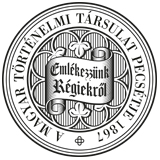Századok – 2000
TANULMÁNYOK - Engel Pál: A török dúlások hatása a népességre: Valkó megye példája 267
A TÖRÖK DÚLÁSOK HATÁSA A NÉPESSÉGRE. 321 Pál Engel LES EFFETS DÉMOGRAPHIQUES DES DÉVASTATIONS: EXEMPLE DU COMITAT VALKÓ (Résumé) Valkó fut un des comitats situés au Sud de la Hongrie, limité au Nord du Drave et du Danube, au Sud du Save. Il fut le premier territoire dévasté par des campagnes militaires turques. Les premières attaques commancèrent en 1390. Entre 1526 et 1536 le territoire du comitat tomba sous la domination turque, il appartenait ensuite au sandjak de Szerém et de Pozsega dont plusieurs registres de taxe (tahrir defter) furent conservés du XVIè siècle. La première partie de l'étude offre une comparaison de ces registres et des inventaires enregistrés entre 1332-1335 qui contient les localités paroissiales. Des localités paroissiales remontant à 122 du XIVè siècle, appartenant à l'évêché de Pécs 74 furent habitées vers 1550, la désertion fut 40%. La perte est due aux campagnes turques, étant donnée que la désertion naturelle des villages ne fut quère fréquente en Hongrie dans le bas Moyen Age. Le plus des localités disparurent au milieu du comitat, le moindres d'elles furent enruinées à l'est. Non seulement de petits villages furent abandonnés, mais p. ex. Nagyeng, située entre Újlak et Szávaszentdemeter qui fut une des plus importantes villes du pays avant 1390 et qui fut entièrement ruinée au cours du XVe siècle. Des Serbes s'y installèrent au cours de la domination turque, elle fut nommée ensuite Vengice. D'autres conscriptions médiévales affirment que le comitat se séparait en deux parties, en une entité du Nord et en une partie méridionale. La deuxième partie de l'étude analyse leurs données. La dévastation de la partie méridionale començait véritablement après 1526: 70% des villages fut abandonné au milieu du XVIè siècle, au moins 80% de la population disparut, elle fut remplacée par des Serbes. Dans la région du Nord la désertion des villages fut 74%, à des localités 90% de la population disparut. Seul la région de Eszék restait à peu près intacte. THE INFLUENCE OF OTTOMAN INCURSIONS ON THE POPULATION: THE EXAMPLE OF VALKÓ COUNTY by Pál Engel (Summary) Valkó Weis one of the southernmost counties of medieval Hungary, its boundaries being the Drava and the Danube in the North, the Sava in the South. This was one of the first territories to be affected by the Ottoman incursions, which began in 1390. After the county had been conquered by the Ottomans between 1526 and 1536, it belonged to the sanjaks of Szerém and Pozsega, whence a number of tax assessments (tahrir defter) prepared by the Ottoman administration in the 16th century have been handed down to us. In the first part of the study the author compares these assessments with the registers prepared between 1332 and 1335, which contain all the localities with a parish church. Out of the 122 parishes belonging to the see of Pécs 74 were inhabited around 1550, which hints at a depopulation of 40 %. Since in Hungaiy natural depopulation was extremely rare in the later Middle Ages, this phenomenon is rightly attributed to the influence of the Ottoman devastations. Distraction was greatest in the central part of the county, the greatest number of localities surviving in the eastern region. Besides small villages important settlements such as Nagyeng (Between Újlak and Szávaszentdemeter), which had been one of the most important towns of the kingdom, were also totally destroyed during the 15th century. Under Ottoman rule it was occupied by Serbs and renamed it as Vengince. Other medieval sources show that important differences existed between the northern and the southern parts of the county. The last part of the study is consecrated to their analysis. In the South destruction was most intensive after 1526: by the middle of the 16th century 70 % of the villages had become uninhabited, and at least 80 % of the population disappeared and was replaced by Serbs. In the North some 74 % of the villages were affected, in some places 90 % of the population disappeared. Only the region of Eszék was relatively spared.
